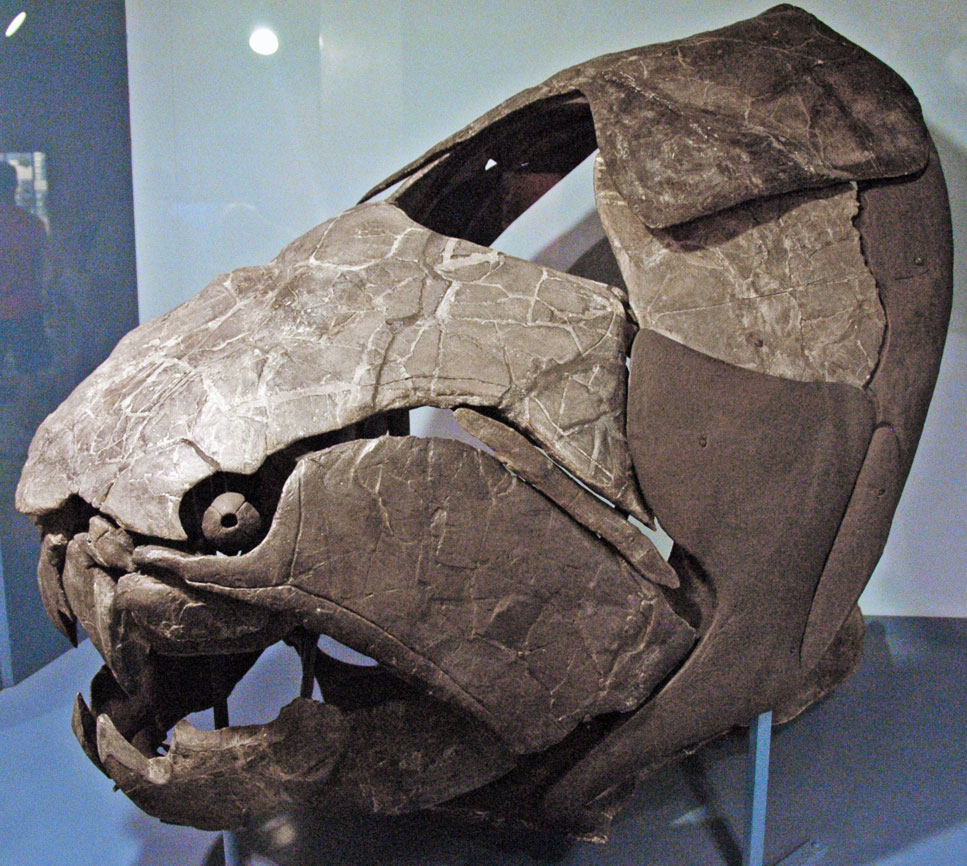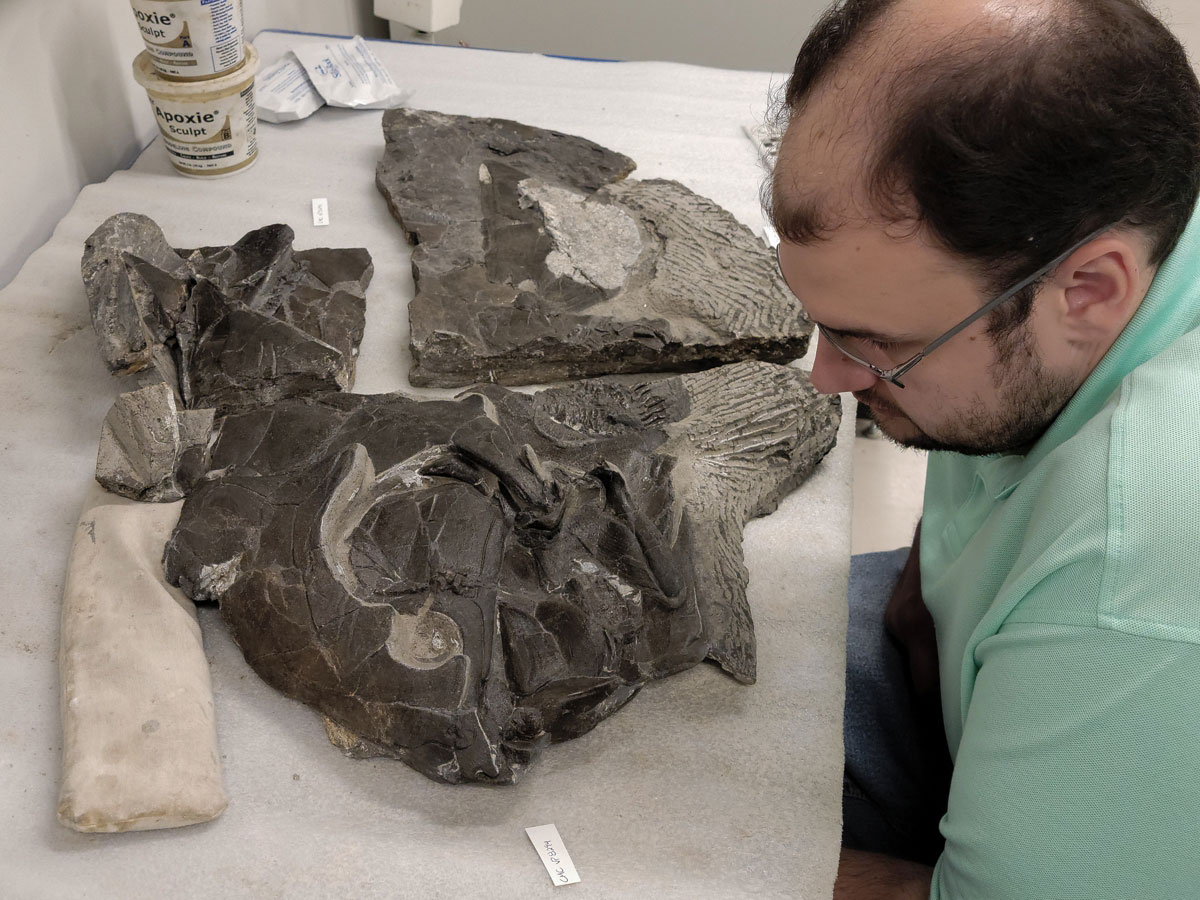
As a young Russell Engelman walks through the visitor hall of the Cleveland Museum of Natural History, there are countless wonders on display. Gems, dioramas, and dinosaur fossils surround him. But his eyes are fixed on one fossil in particular: The skull and body armor of a giant fish, Dunkleosteus. Dunkleosteus is an arthrodire, one of a large group of armored fishes which dominated the oceans during the Devonian Period, between 420 and 360 million years ago. And while Engelman is impressed by the skull and bladed jaws in front of him, he cannot help but wonder where the rest of the animal is. He would later learn that most of the skeleton of Dunkleosteus (and other arthrodires) is made of cartilage, a soft material which usually does not fossilize. As a result, most of what Dunkleosteus’ body looks like was a mystery.
 Mount of Dunkleosteus skull CMNH 5768 on display at the Cleveland Museum of Natural History. This display inspired a love of paleontology in countless visitors including Russell Engelman and the author of this blog. Photo by James St. John (Earth Sciecnes, Ohio State University). Photo obtained from Wikimedia Commons and used under Creative Commons Attribution 2.0 Generic license. Over 25 years later, Engelman, now a researcher at Case Western Reserve University, has published a new paper in Palaeontologia Electronica demystifying the body plan of this great fish. He combines updated observations of the fish’s anatomy with the anatomy of its close relatives and clues from the environment it lived in to create the most accurate reconstruction of Dunkleosteus to date. Engelman is quick to note that “This reconstruction isn't perfect and will probably be modified by future discoveries,” but he is also confident that “the overall size and body shape of this reconstruction is close to what the animal actually looked like.”
Mount of Dunkleosteus skull CMNH 5768 on display at the Cleveland Museum of Natural History. This display inspired a love of paleontology in countless visitors including Russell Engelman and the author of this blog. Photo by James St. John (Earth Sciecnes, Ohio State University). Photo obtained from Wikimedia Commons and used under Creative Commons Attribution 2.0 Generic license. Over 25 years later, Engelman, now a researcher at Case Western Reserve University, has published a new paper in Palaeontologia Electronica demystifying the body plan of this great fish. He combines updated observations of the fish’s anatomy with the anatomy of its close relatives and clues from the environment it lived in to create the most accurate reconstruction of Dunkleosteus to date. Engelman is quick to note that “This reconstruction isn't perfect and will probably be modified by future discoveries,” but he is also confident that “the overall size and body shape of this reconstruction is close to what the animal actually looked like.” Engelman examining a Dunkleosteus fossil (CMC VP8294) housed in the Cincinnati Museum Center. This specimen preserves the complete head, body armor, and front paired fins. Picture provided by Russell K. Engelman.
Engelman examining a Dunkleosteus fossil (CMC VP8294) housed in the Cincinnati Museum Center. This specimen preserves the complete head, body armor, and front paired fins. Picture provided by Russell K. Engelman.
Engelman initially had no intention of working on Dunkleosteus itself. “Dunkleosteus is one of the most studied arthrodires from the Cleveland Shale,” explained Engelman. “My goal was to examine other arthrodire species from this area, thinking that Dunkleosteus was already well-understood.” However, he quickly realized that even the most famous of the armored fishes was in need of more research. “It rapidly became apparent that there wasn't any clear idea of this animal was supposed to look like in life. Most depictions were entirely speculative.” Reconstruction of Dunkleosteus based on information presented in the new paper. Note the relatively short and stout body plan, as well as the armor covering nearly half of the body. Figure 4 in the new paper.
Reconstruction of Dunkleosteus based on information presented in the new paper. Note the relatively short and stout body plan, as well as the armor covering nearly half of the body. Figure 4 in the new paper.
The newly-published reconstruction of Dunkleosteus has some striking differences from those in years past. For one, it is shorter than previously thought and has a much deeper torso than the shark-like body it was usually given. The front paired fins of Dunkleosteus were small and located close to the head, similar to some ocean-going sharks like great whites. The body armor covers nearly the first half of the body, with the rear paired fins located just behind the armor at roughly half total body length. Many past depictions ended the armor too soon. Arthrodires in general tend to exhibit shorter and body plans than the sharks which have often been used to reconstruct the anatomy of Dunkleosteus, and this new paper shows Dunkleosteus is even stockier than other arthrodires. Altogether, these features suggest Dunkleosteus had a “tuna-like” body plan, which has independently evolved multiple times in fish, reptiles, and mammals which call the open ocean their home.
To Engelman, the most important findings in this work are less about Dunkleosteus in particular but rather arthrodires as a whole. “Before, many parts of the arthrodire body plan were treated as mostly unrelated,” Engelman explained. He recounts how colleagues assumed an arthrodire’s body armor would not give much information on the animal’s body shape, meaning a study like this would not be worthwhile. “But now we know arthrodires like Dunkleosteus, Coccosteus, and Amazichthys have a relatively consistent body plan. This gives us a much better idea of how these animals work, and how we can start putting together arthrodire fossils which are much less complete.” Fossil and reconstruction of Coccosteus, a small relative of Dunkleosteus. The distinct bend in the tail is common in fossils of this fish, which Engelman interprets as evidence of a forked tail like that of sharks. Another arthrodire, Amazichthys, also has soft tissue preservation showing a forked tail. Figure 7 in the new paper. B provided courtesy of the Royal Ontario Museum, used with permission.
Fossil and reconstruction of Coccosteus, a small relative of Dunkleosteus. The distinct bend in the tail is common in fossils of this fish, which Engelman interprets as evidence of a forked tail like that of sharks. Another arthrodire, Amazichthys, also has soft tissue preservation showing a forked tail. Figure 7 in the new paper. B provided courtesy of the Royal Ontario Museum, used with permission.
A consistent body plan also suggests a successful body plan. While older works have suggested that arthrodires were on borrowed time until the ‘more efficient’ sharks and bony fish drove them to extinction, growing evidence points to arthrodires as well-adapted to the Devonian seas and highly successful in their varied niches. “A good example of this is the tail fin,” Engelman notes. “Early studies considered arthrodires, including Dunkleosteus, poor swimmers with eel-like tails. This has been challenged for later arthrodires like Dunkleosteus and Amazichthys, but earlier species like Coccosteus were still assumed to be poor swimmers. When I looked at fossils of Coccosteus, though, many of them showed a very clear bend in the spine which we would expect if they had a shark-like tail fin. With this split tail associated with active swimming present in both early and late arthrodires, the group overall were likely strong and fast swimmers.”
The new reconstruction of Dunkleosteus opens several new paths for future research. For one, Dunkleosteus is part of a larger story of ecological change in the Devonian period. Before this time, ocean life was mostly restricted to the coasts and lived close to the seafloor. By the late Devonian, though, animals began living in deeper waters and more of them were active swimmers. What caused this shift in habitat and how arthrodires like Dunkleosteus moved into the apex predator role are open questions. For another, living fish with Dunkleosteus’ size and body type, like tunas and white sharks, tend to be better at keeping their core warm than other fish. Engelman is interested if this trend extends to fish as old as Dunkleosteus as well, which the bones’ internal structure or isotope makeup may shed light on.
What Engelman is most interested in, though, is how Dunkleosteus and its fellow armored fish swam. “From a biomechanical standpoint, arthrodires make no sense,” he explained. “For instance, these animals have heads that cannot move from side to side. In most living fishes, bending of the head is required to be able to turn. How did arthrodires even turn? We just don’t know.” Engelman’s reconstruction lays the groundwork for detailed 3D modeling of Dunkleosteus and other ancient fish, where questions like this can be tested. Range of body lengths and tail shapes possible for a typical adult Dunkleosteus. Reconstructions like this are invaluable both to artists and museum personnel depicting the animal and to researchers trying to model its behaviors. Figure 9 in the new paper.
Range of body lengths and tail shapes possible for a typical adult Dunkleosteus. Reconstructions like this are invaluable both to artists and museum personnel depicting the animal and to researchers trying to model its behaviors. Figure 9 in the new paper.
Beyond Dunkleosteus or even arthrodires, Engelman hopes that his work will encourage other paleontologists to publish more reconstruction-focused papers. “Papers focusing on skeletal or life reconstruction used to be common practice in the late 19th and early 20th centuries, but have since become less popular. To paraphrase Kenneth Carpenter: when you try to reconstruct a fossil organism, it becomes very apparent what the organism can or cannot do. You see where certain parts have to go, or what arrangements are impossible because it would require bones to overlap or be dislocated.” Engelman also highlights the importance of collaboration between researchers and other specialists. “Many important observations are made by paleoartists and museum professionals, because they are the ones dealing with how to reconstrruct extinct animals for a practical display. But these observations rarely make it into the primary literature. My hope that this research will encourage these individuals to publish their observations and contribute to ongoing discussions about ancient life.”
This study is titled ‘Reconstructing Dunkleosteus terrelli (Placodermi: Arthrodira): A New Look for an Iconic Devonian Predator’ and was authored by Russell Engelman (Case Western Reserve University, Cleveland, Ohio, USA).
To discover more about this research, you can read the full publication here: https://doi.org/10.26879/1343

